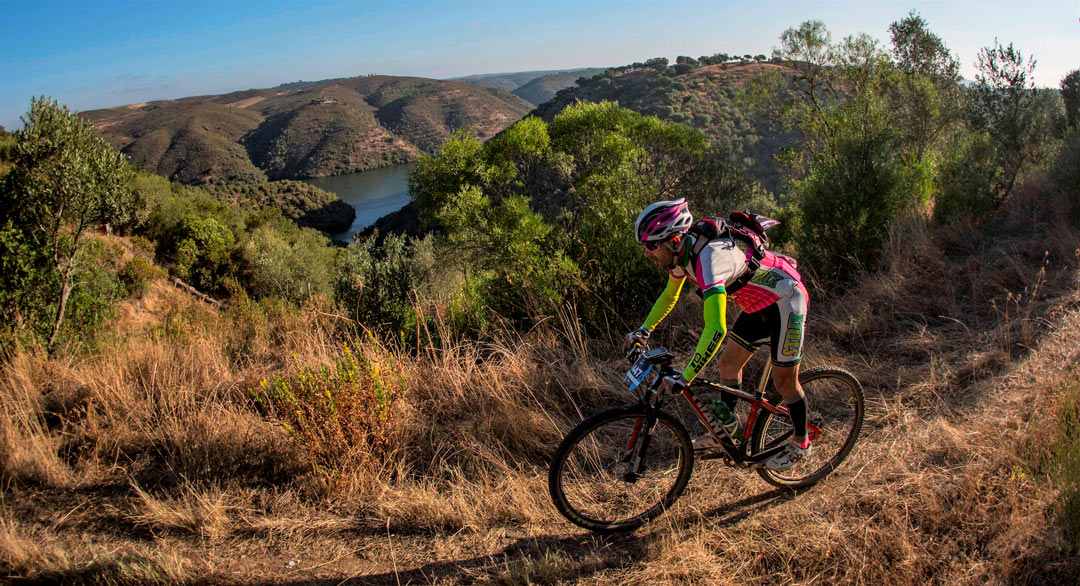A world of adventures
at Tajo Internacional
Thanks to its varied landscapes, its outstanding relief, and its great natural richness, this territory is the perfect setting for enjoying so-called active or adventure tourism. The great River Tajo and its tributaries, waterfalls, quarries, reservoirs, streams, uplands, and dehesas dotted with remains of the past are the ideal territory for tourism and for enjoying different sporting disciplines

We will tell you below about some of the activities that you can take part in either alone or in a group in the Tajo Internacional Biosphere Reserve.
The best enclave of Tajo Internacional for diving is the Alcántara Quarry. Its calm crystal-clear water provides enthusiasts of this sport with a very special inland spot. Many people choose it for starting to learn to dive. Moreover, this spectacular crag holds colonies of black storks and Egyptian and other vultures.
If you decide to carry out this activity on your own, please contact the Nature Reserve to ensure that there are no current restrictions.

When you board the ‘Balcony of the Tajo’ you get much more than a pleasant boat trip on the Tajo. Various routes explore the river and its tributaries on both sides of the border (La Raya) in the form of very didactic guided tours, which are highly recommended for family tourism.

Routes for kayaks, kiteboarding, paddle surfing, and windsurfing; these are some of the sports which can be practised in the waters of the Alcántara and Cedillo Reservoirs.

4×4 Route in the Sierra de San Pedro
Get to know in a 4×4 the Sierra de San Pedro, one of the best examples of Mediterranean woodland in the whole of Europe, and enjoy the wildlife of the reserve: red deer, roe deer, hares, vultures, mouflon… An incredible experience to enjoy as a family! We recommend that you use sun block as the route is followed in an open 4×4 vehicle.
4×4 Route in the Tajo Internacional Nature Reserve
Enjoy Alcántara and the surrounding area and breathe in the fresh air of the Cross-border Biosphere Reserve. Moreover, an expert guide will tell you all the details of the fauna, flora, and history of the area. Don’t forget your binoculars!
The quartzite rock of ‘Puerto Roque’ in the municipal district of Valencia de Alcántara is a veritable paradise for climbers. This huge rock, which marks the border between Spain and Portugal, offers over fifty routes on which you can begin to learn to climb. On the Fexme website you will find all the officially approved routes.

For millennia the extraction of cork has been one of the most sustainable ways of exploiting the woodland.
Now you can follow a route in a 4×4 in cork oak groves of Valencia de Alcántara to get to know the secrets of the ‘jatera’ and the extraction process.
One of the best ways of getting to know the Biosphere Reserve is by bike. You can go in for cycle touring or MTB riding thanks to the new centre and the routes which have been marked all over the Reserve. Moreover, there are endless horse-riding routes for discovering all parts of the district.

‘Slow tourism’ on two or four wheels is in fashion. At Tajo Internacional you will find outstanding rural areas of great natural beauty and cultural value. The following routes stand out: the road between Membrío and the jetty of Herrera de Alcántara which passes through Carbajo and Santiago de Alcántara, and the road between Garrovillas de Alconétar and Zarza la Mayor which passes through Mata de Alcántara and Alcántara. Wind down the window and enjoy!
The Reserve includes several megalithic treasures which are considered to be among the most interesting in Europe: there are 148 dolmens to visit on various routes. The Cross-border Route of Valencia de Alcántara has the dolmen of El Mellizo, which is exceptionally well preserved, and the Data I and II ensembles. At Alcántara you can visit the impressive Menhir del Cabezo. For its part, Cedillo has 43 megalithic remains. The cave paintings of Puerto Roque in Valencia de Alcántara and El Buraco in Santiago de Alcántara are also worth admiring. Finally the Berrocal de la Data, which has been declared a Natural Monument of Extremadura, will leave you open-mouthed.


